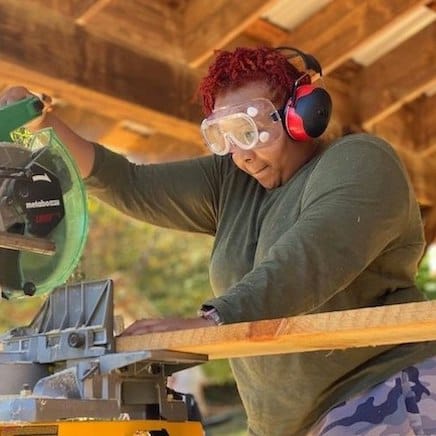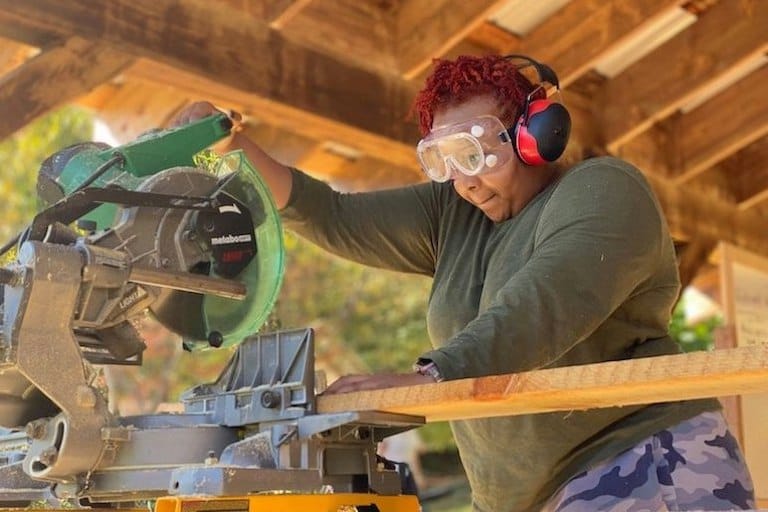On This Page
We welcome you to read through this page for a whole-picture perspective on our Woodworking Classes for Adults. If you’re looking for specific information, you can use the following links to skip around:
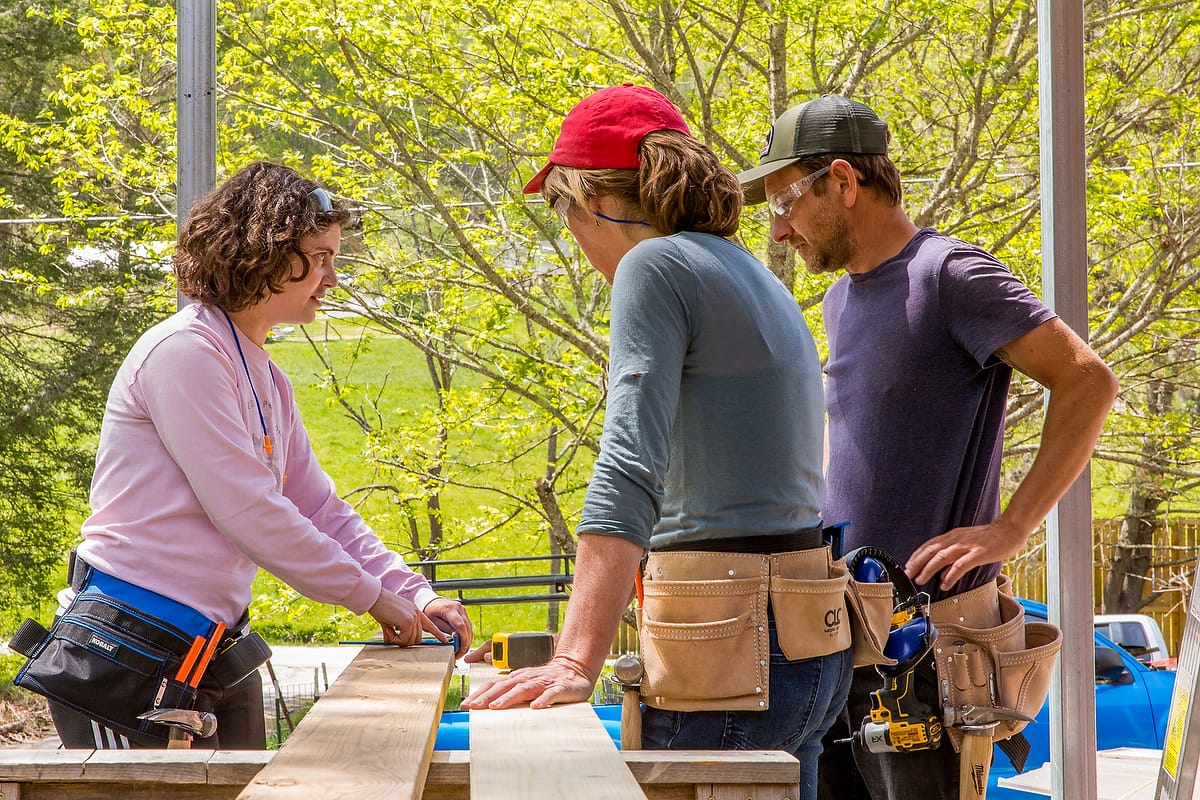
Satisfy your inner carpenter in our woodworking classes for adults.
In a culture that’s zooming toward virtual reality and digitizing the day-to-day, not everyone grows up learning how to use tools and work with their hands. Our carpentry and woodworking classes for adults are here to change that.
Surrounded by nature in our beautiful, sheltered outdoor classroom, they’re perfect for total beginners and folks who have used tools, but don’t feel totally comfortable with them yet.
Our classes are set up to foster community, and during your time here, whether you camp onsite or stay in a hotel or airbnb, you can experience the sweet nostalgia of summer camp as you make new friends and learn useful skills in this adult version of a woodworking camp.
Learning carpentry can be rewarding and satisfying whether you want to feel confident fixing things around the house, plan woodworking projects for yourself, or interact with folks you hire in a confident way.
Studies have shown that working with our hands actually increases “happy hormones” in our brains like serotonin. Our adult woodworking classes are here to welcome everyone to the world of carpentry and a more hands-on lifestyle.
We also offer Women’s Woodworking Classes for women and non-binary folks who feel more comfortable in that gender dynamic.
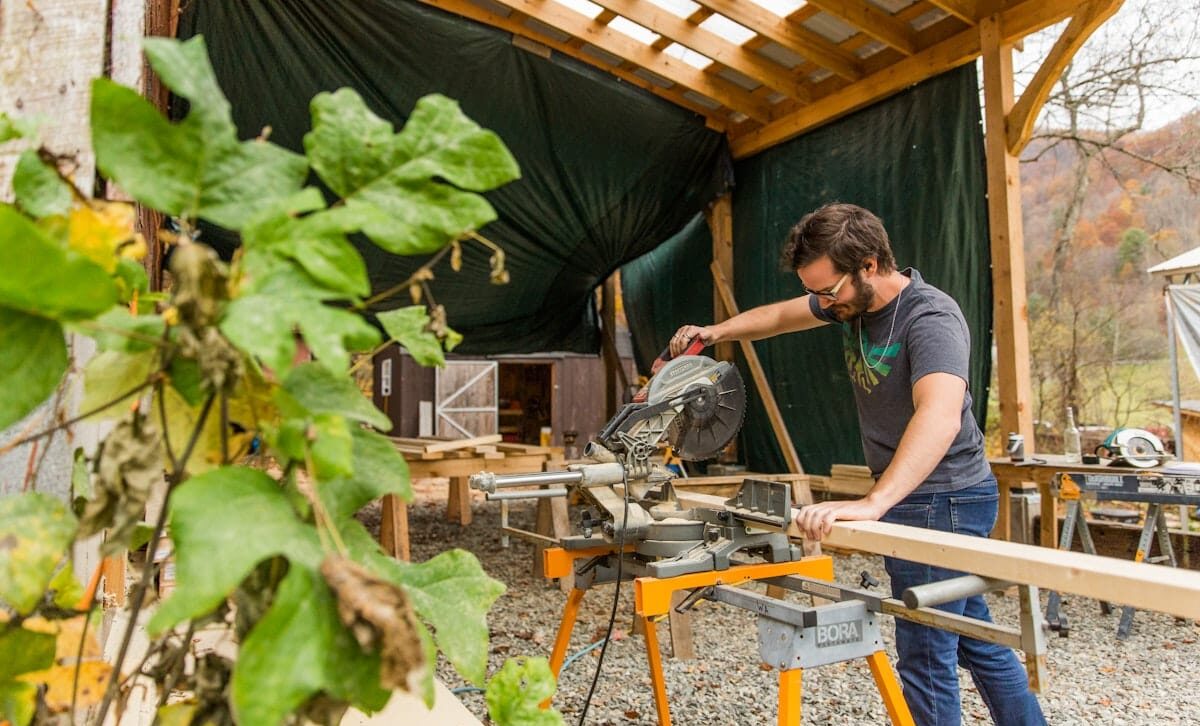
“The Adult Beginner Woodworking Class was a profound experience for me. Having two female instructors in the mix allowed me to let go of the junk that women can’t use power tools; that this is men’s work. They were also great at breaking things down, keeping our group moving and engaged, and were sensitive to people with different learning styles or when people were struggling. I heard several people say, ‘I feel so empowered!.’ I just wish I could go back and relive those four days!” —Amanda, Rhode Island, Filmmaker
These Asheville, NC adult woodworking classes are for both total beginners and those with a little bit of experience.
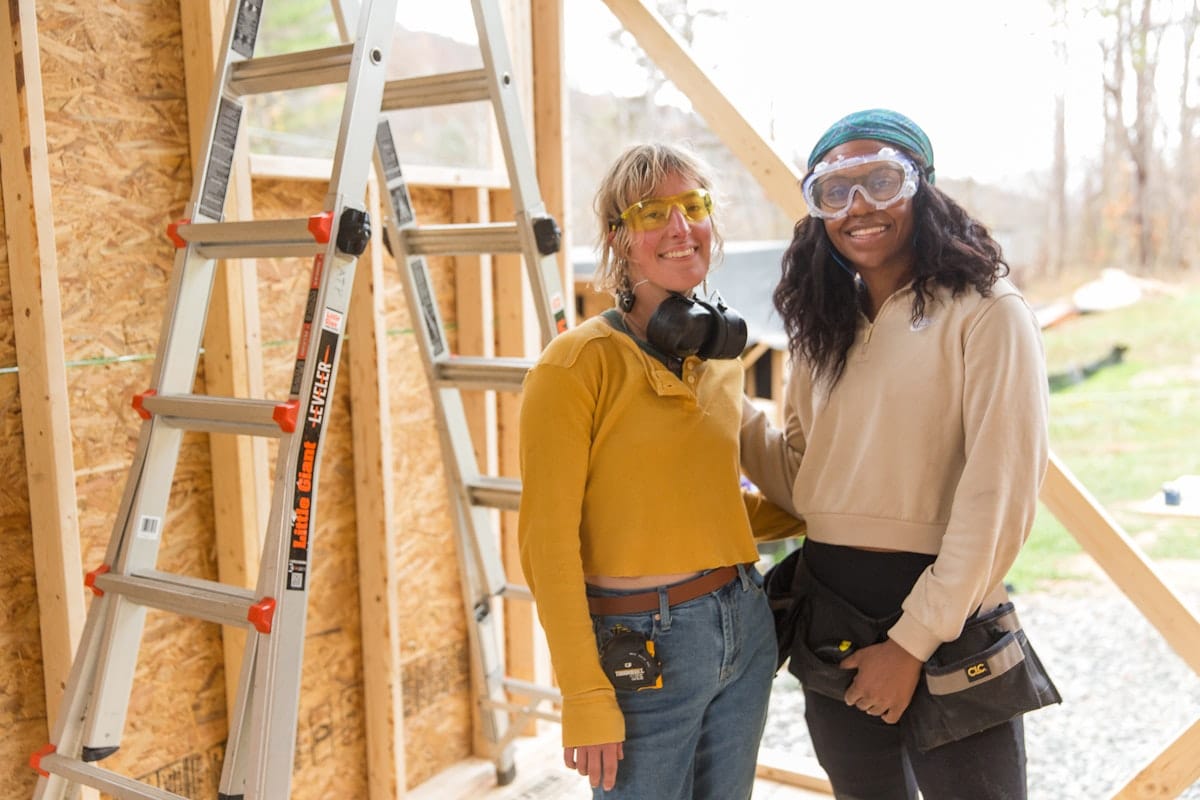
You’ll learn to use tools and grow confident with them by working on various projects. You don’t need any experience to join our woodworking classes for beginners. However, if you’ve used the table saw, chop saw, circular saw, and other hand tools, but don’t feel like you have a mastery over them, this is also the woodworking class for you.
If you’re interested in bigger projects and structural building, we offer a 5-day Women’s Advanced Carpentry Course for graduates of the basic class who are women and non-binary, and a 10-day Tiny House Workshop, which is open to everyone. After you’ve completed one of our carpentry and woodworking classes for beginners, you are qualified for the advanced classes.
We set the stage by creating a comfortable, relaxed, and fun “woodworking camp” environment. No pressure to “get things done.” Instead we focus on learning.
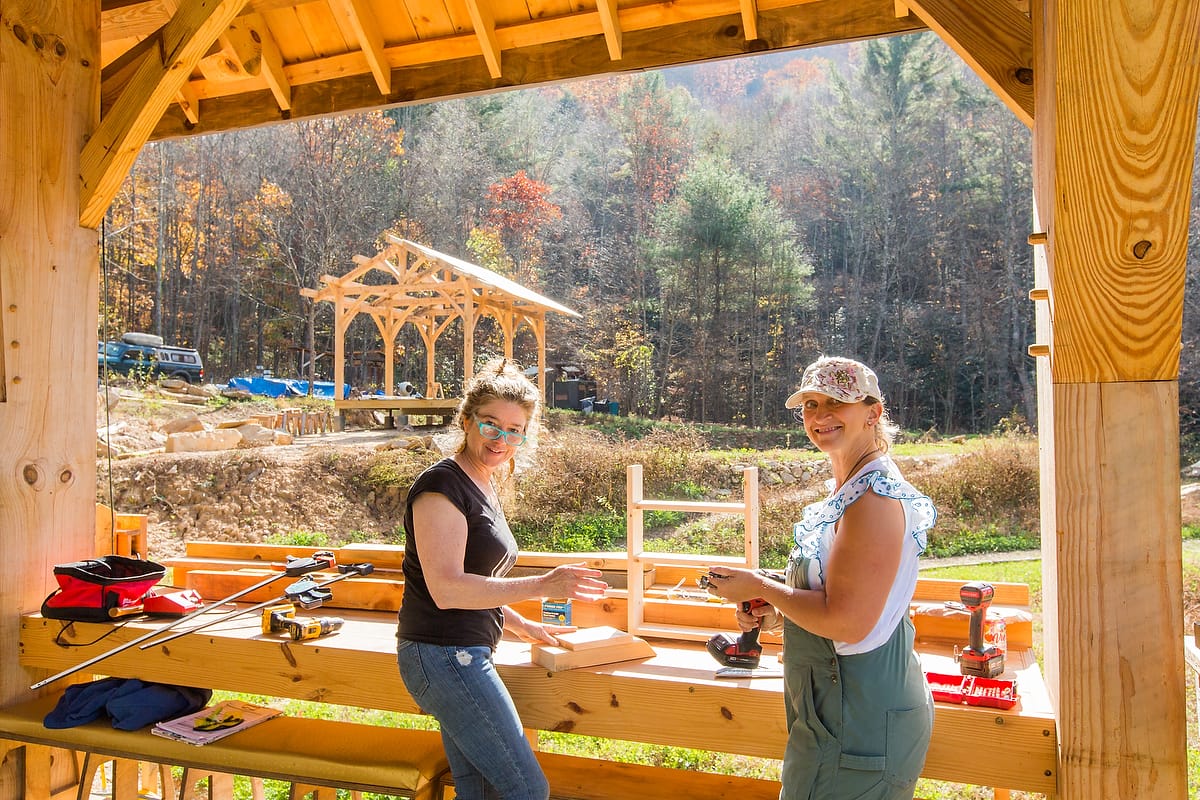
Ready to Join?
Join the waitlist to be the first to know when the class opens for registration!
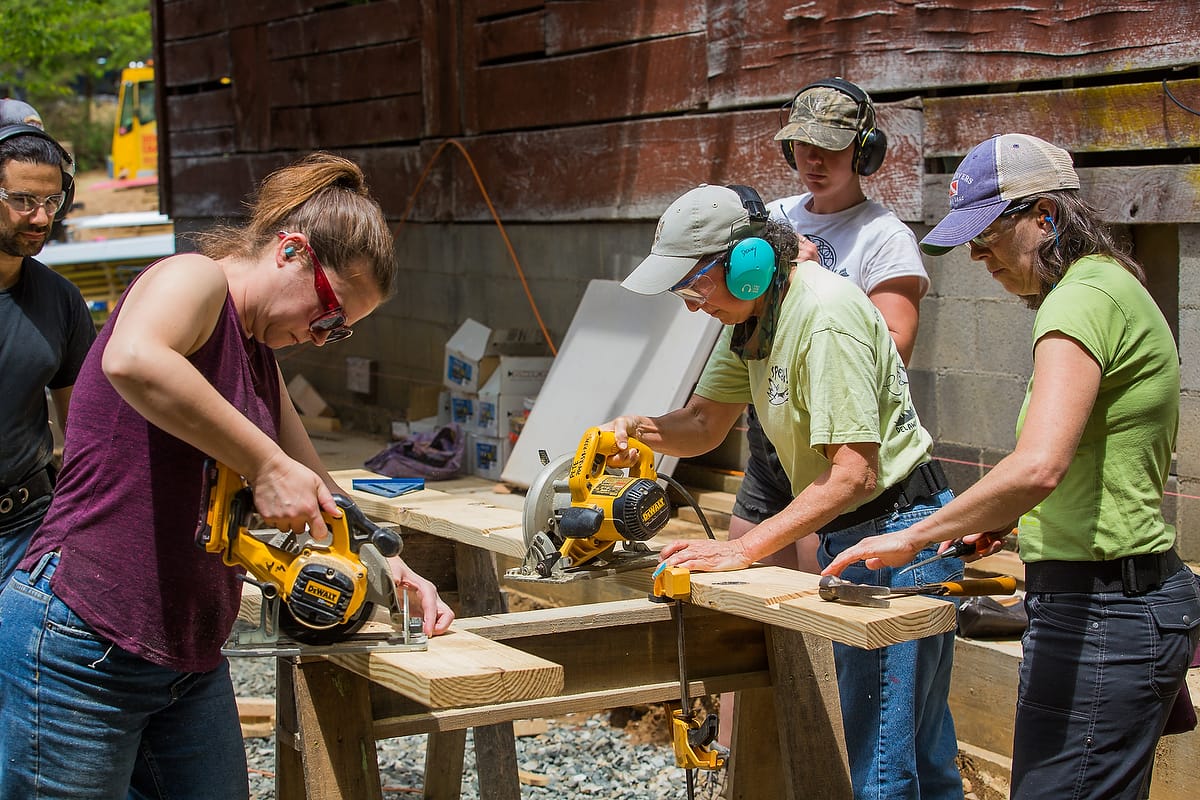
What to Expect: A Four Day Woodworking Camp for Adults
During our four-day woodworking classes for adults, we cover basic carpentry skills through lectures, demonstrations, and lots of hands-on practice.
Topics covered in our adult woodworking classes include:
- Learning which tool should be used for which purpose
- How to measure and cut accurately
- How to use power saws and hand tools safely and effectively
- The basics of wood: strengths, weaknesses, and how to choose the right board
- Designing and creating your own project to take home
This wealth of information will be shared in a way that meets everyone where they’re at and welcomes engagement. We firmly believe that there are no “wrong questions.”
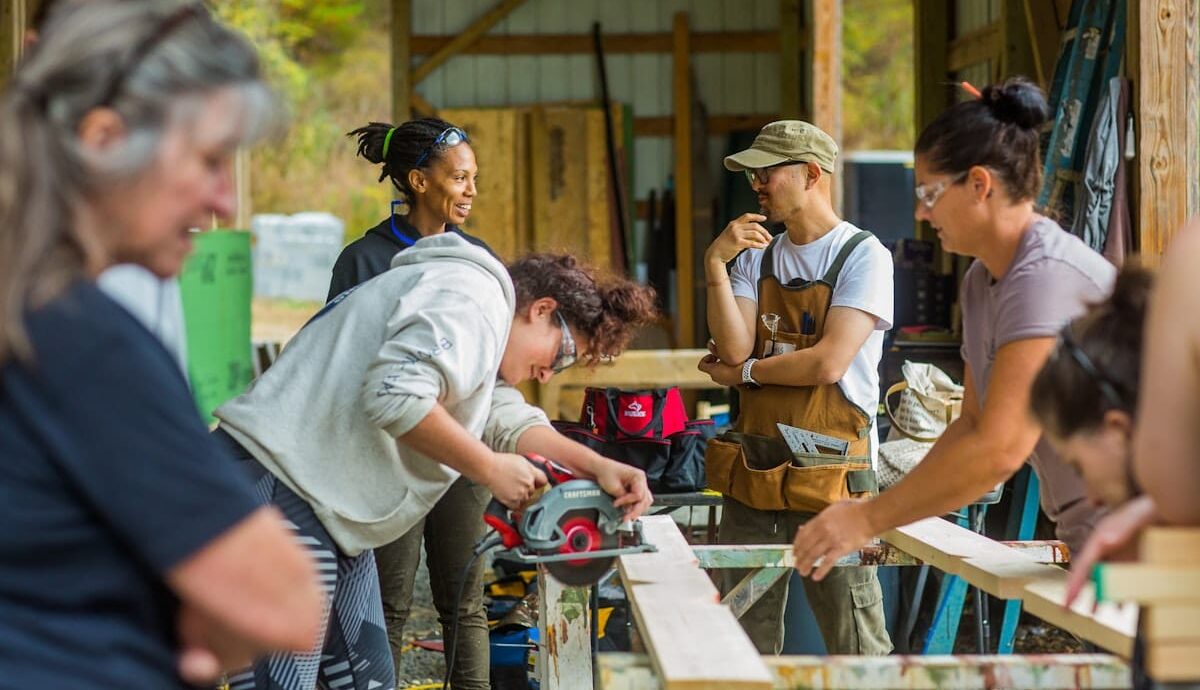
Adult Woodworking Classes: Schedule and Timing
We take an hour-long lunch break each day with the following schedule:
- Day 1: 9:00am – 5:30 pm
- Day 2: 9:00am – 5:30 pm
- Day 3: 9:00am – 5:30 pm
- Day 4: 9:00am – 4:30 pm
Class ends by 4:30pm on the last day, and students may leave whenever they finish their personal projects on this day. This can be as early as 3:00pm if they have time constraints and choose a very simple project. During our lunch break on Sunday we hold a closing circle, which we encourage everyone to stay for, if they’re able.
Please note: Some classes will have slight changes in the schedule due to weather, the needs of the projects, and the desires of the group.
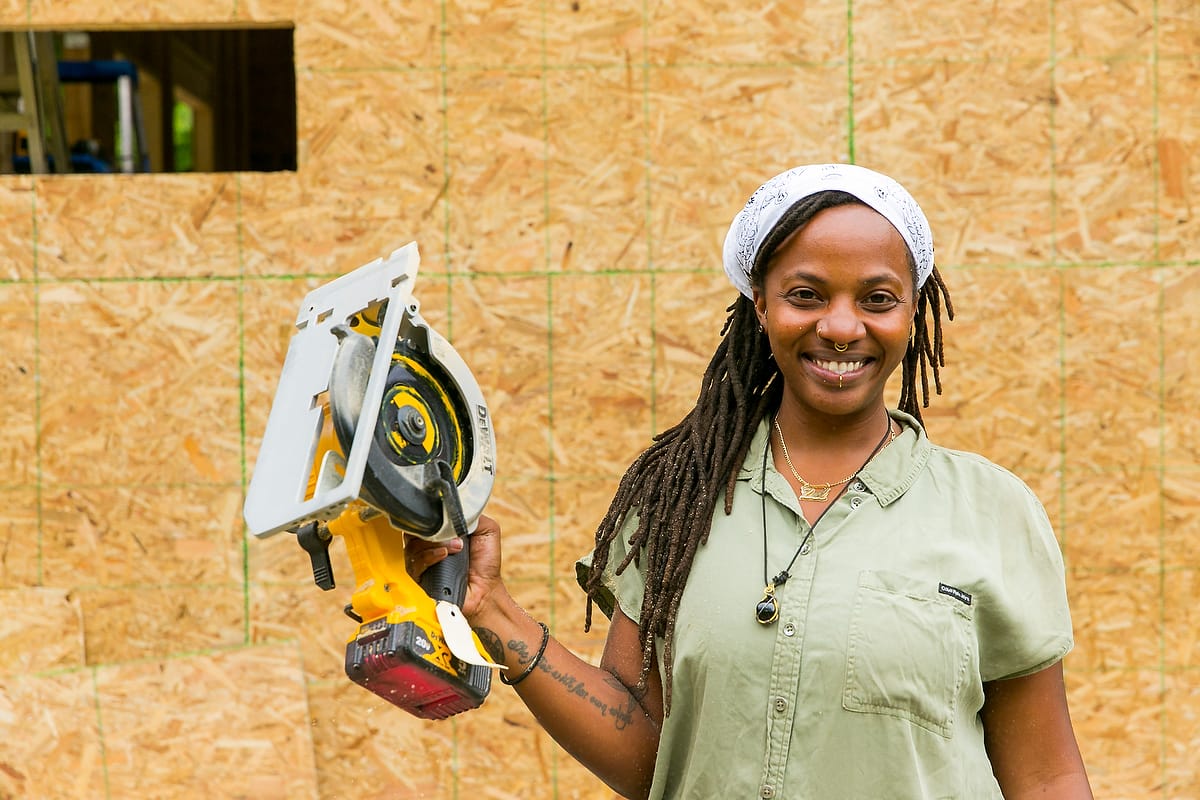
Day 1: Get A Handle on Woodworking and Carpentry Tools
To begin, we’ll have an orientation and overview of the wood shop and class flow and details. Then, we’ll move into tools that we may use in this woodworking class for adults. We’ll address which tools to use when, safety, and ergonomic use. You will get a chance to see each tool demonstrated, and then you’ll practice using it yourself, with lots of guidance and support, of course!
In order to promote a sense of safety and mastery, when we get into the circular saw, table saw, and sliding mitre saw (the more intimidating tools), we break the class into three groups, to make sure everyone gets the focus that they need.
Tools we’ll cover on day one include:
- Safety equipment
- Carpenter’s pencil
- Measuring tape
- Utility knife
- Speed square
- Table saw
- Miter saw and sliding miter saw (aka, chop saw)
- Circular saw
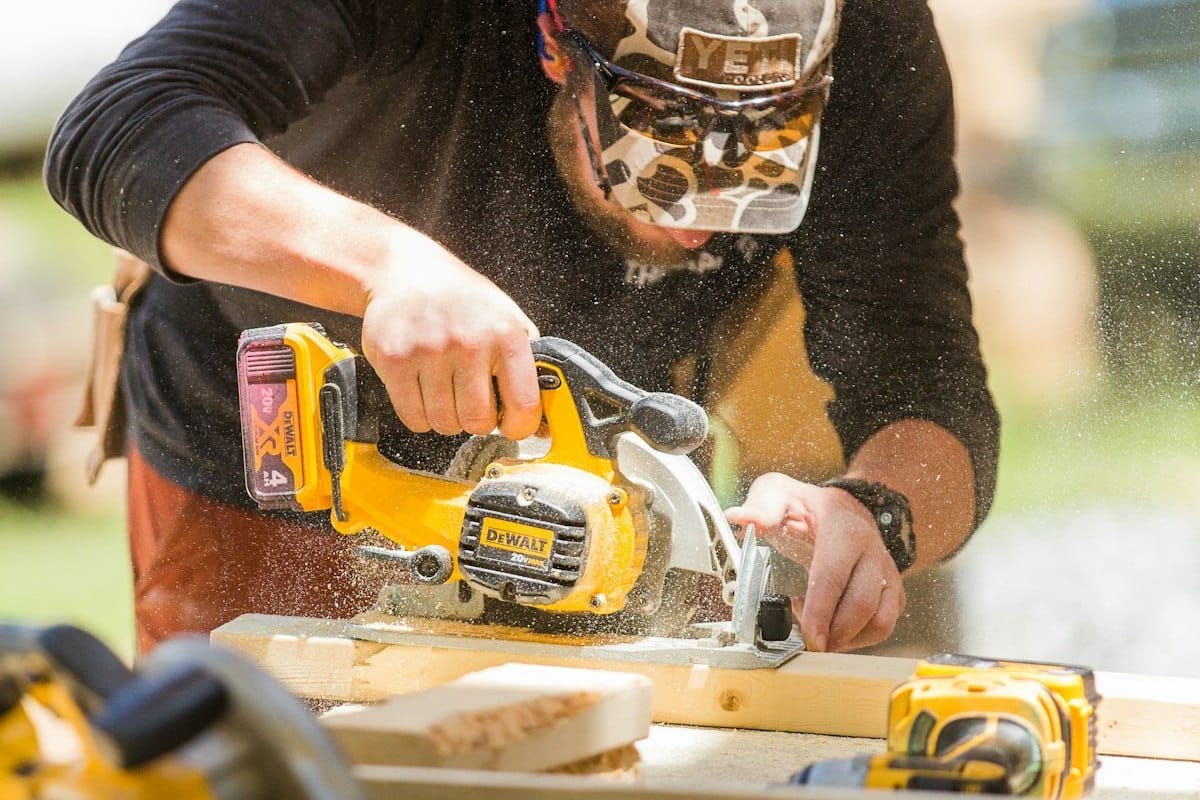
Day 2: Project Design, More Tools, and A Field Trip
Plan out your personal project, explore more tools, and learn to navigate a lumber yard!
On day two, we’ll get our hands on more tools, learning safe and proper use of drills, drivers, drill bits for making holes in wood and driver bits for driving screws into wood.
Your Personal Woodworking Project
On the second day of our woodworking classes for beginners, you’ll also choose and design your own small personal project (to be built on day four). To do this, you’ll get plenty of support and guidance from the instructors. In order to ensure every student’s success within our timeframe, we limit personal projects to a selection of simple objects. You can choose to build a tool caddy, small shelf, or a birdhouse.
After lunch, we’ll leave the woodshop and head to the lumber yard to pick out materials for everyone’s personal projects. While we’re there, we’ll explore lumber selection and how to choose a straight board (surprise, not all boards are straight!). Before the field trip, we’ll discuss what kinds of woods are appropriate for your projects and go over what types of screws or other fasteners you’ll need. Equipped with this knowledge, everyone will buy what they need for their personal projects.

Day 3: Final Tools and Group Project
We’ll have our last tool class, covering:
- Chalk lines
- Levels
- Hand saws
- Hammers
- Cat’s paws
After lunch, we will transition to group projects. The point is not to get things done quickly, but rather to focus on gaining muscle memory and mastery of tools that have been covered already in the class.
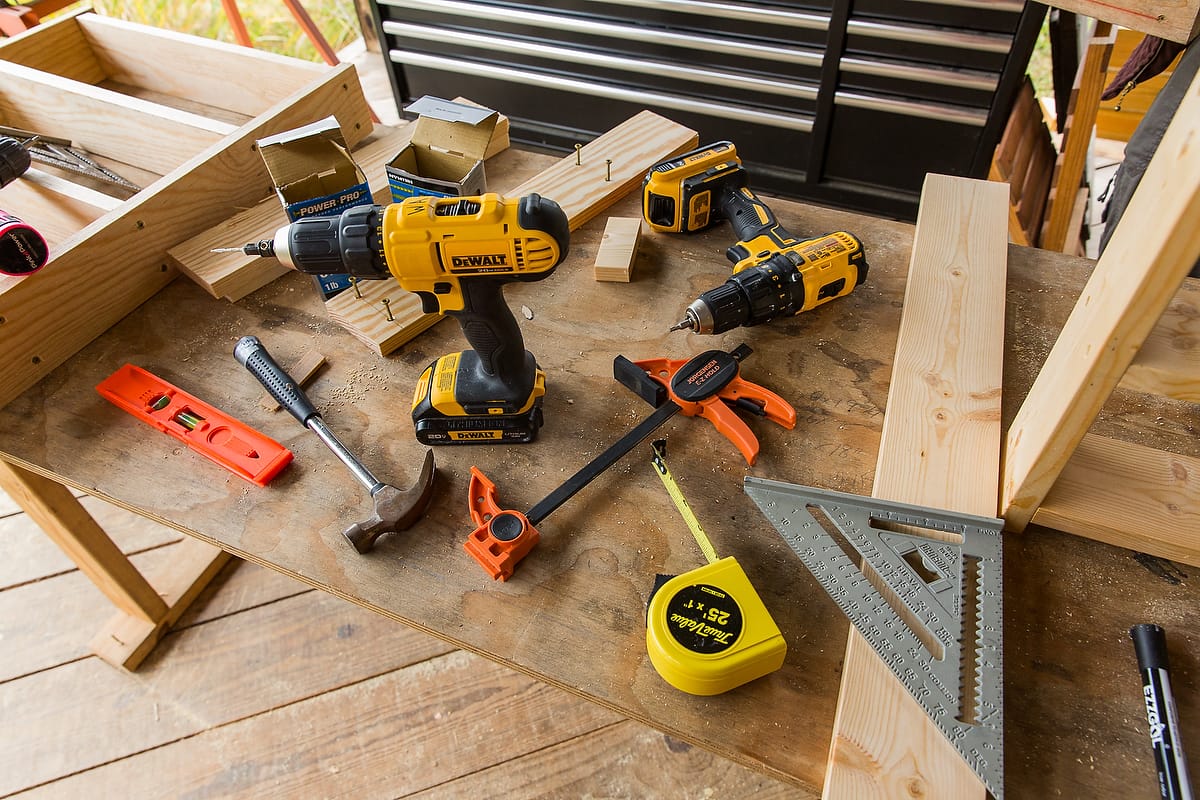
No matter what the specific projects are, they’re always something real; you won’t just be cutting and screwing scrap wood; you’ll be contributing to building something useful. We choose group projects appropriate for the skill level of the class so that students get an opportunity to practice the techniques that are foundational to carpentry and woodworking for adults. The work may be done on projects to be donated to flood victims, on one of the buildings of our campus, or a building to be sold to community members.
Here are some examples of projects we’ve worked on in the past:
- Putting diagonal sheathing or siding on a shed or other building
- Building a picnic table
- Working on a deck
- Building a fence
- Building shelves
- Building a bridge over a small creek
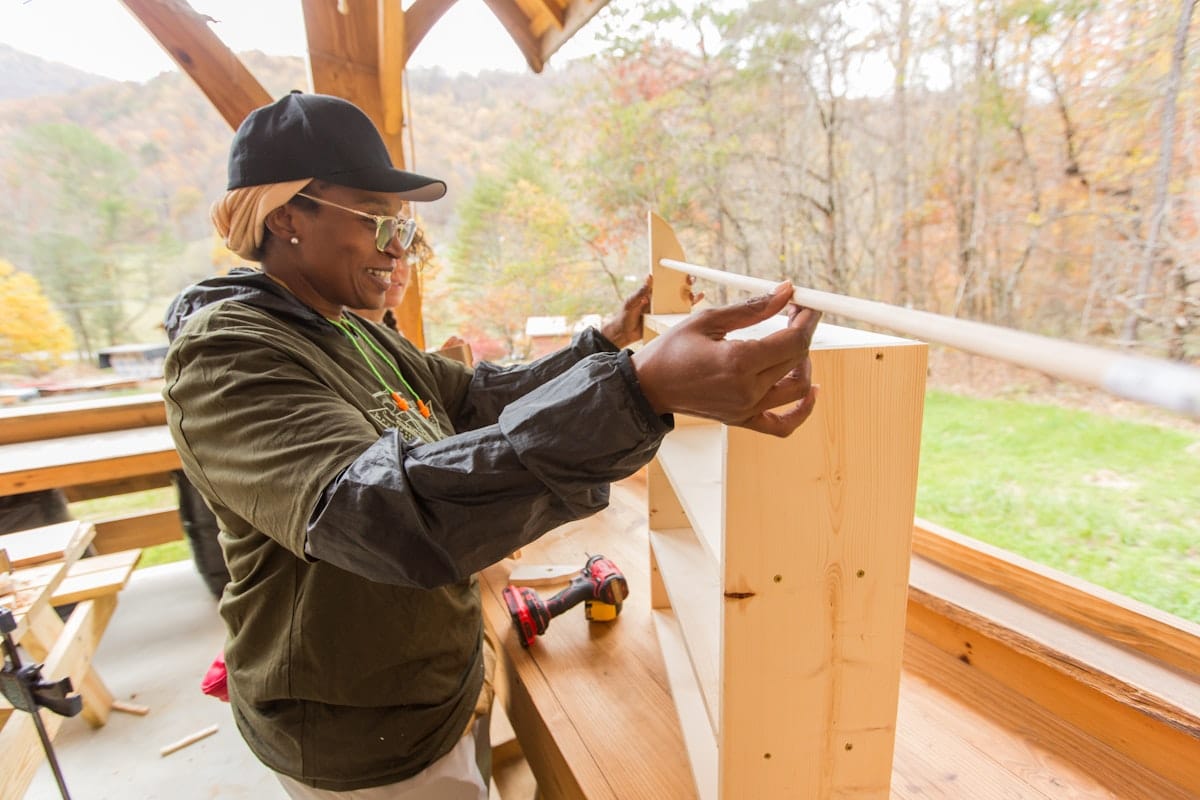
Day 4: Your Own Woodworking Project
You’ll get all the support you need to complete your project and learn while doing so. We try to equip our students with the skills and confidence to be able to design and create projects on your own, once you leave class.
On day two you made a cut list and a materials list, and you purchased the boards for your personal project. Now is when you will use your design to cut your boards, assemble your creation, and fasten its pieces together to finish your woodworking camp experience. Instructors will be guiding you through the process.
Ending Time for this Woodworking Class:
On day four we’ll close up the wood shop at 4:30pm (earlier than days 1-3). Individuals will be done with the class when they complete their personal projects (usually between 3:30 and 4:30). If you have time constraints, we advise you to choose a simple project like a small shelf.
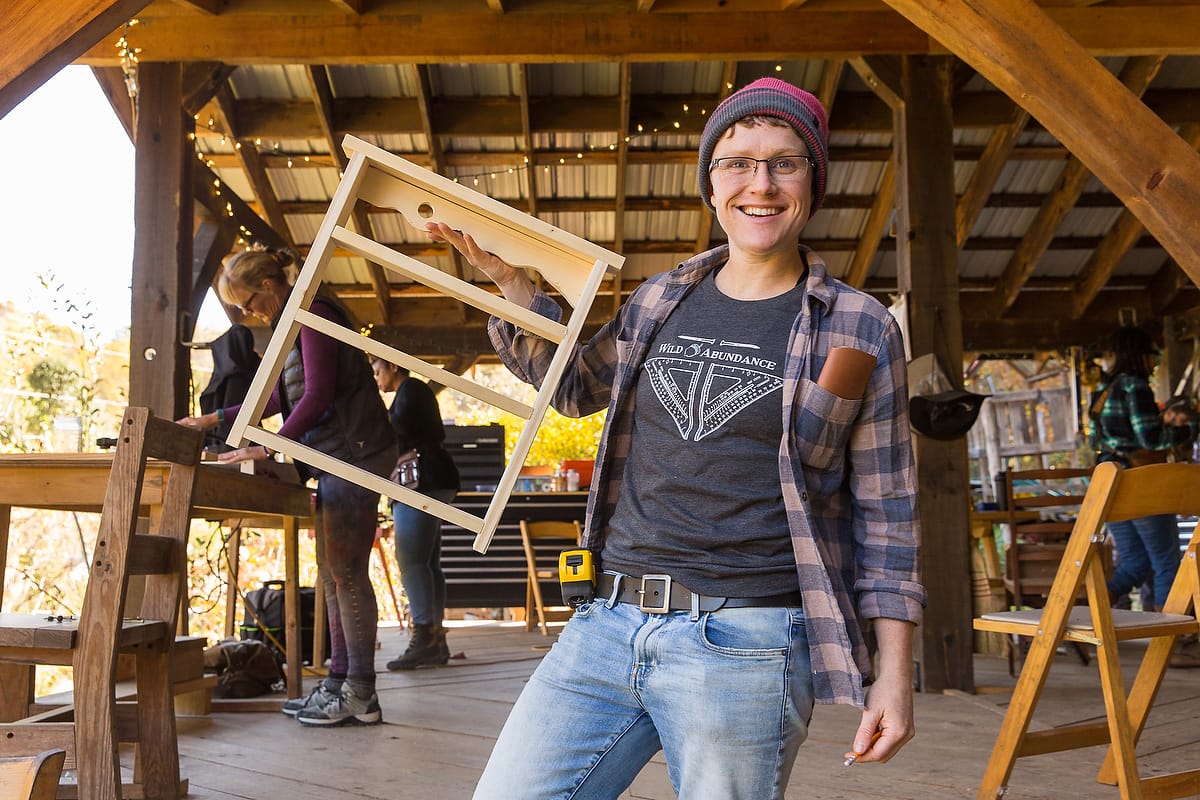
Enjoy our beautiful outdoor woodworking classes for adults near Asheville, NC.
Our woodshop for this class is located at the lovely Wild Abundance Paint Fork Campus. During the class, we’ll work in several covered areas amidst mountain views and native plants. There, students can use tools and work on projects with fresh air and a gorgeous backdrop.
As a result, many folks who come to learn carpentry also get excited about the other things we do here, like organic gardening and permaculture courses. Additionally, getting to learn and work in this simple, outdoor wood shop can be very inspiring. Please note: class happens mostly outdoors (under cover), rain or shine, whatever the temperature.
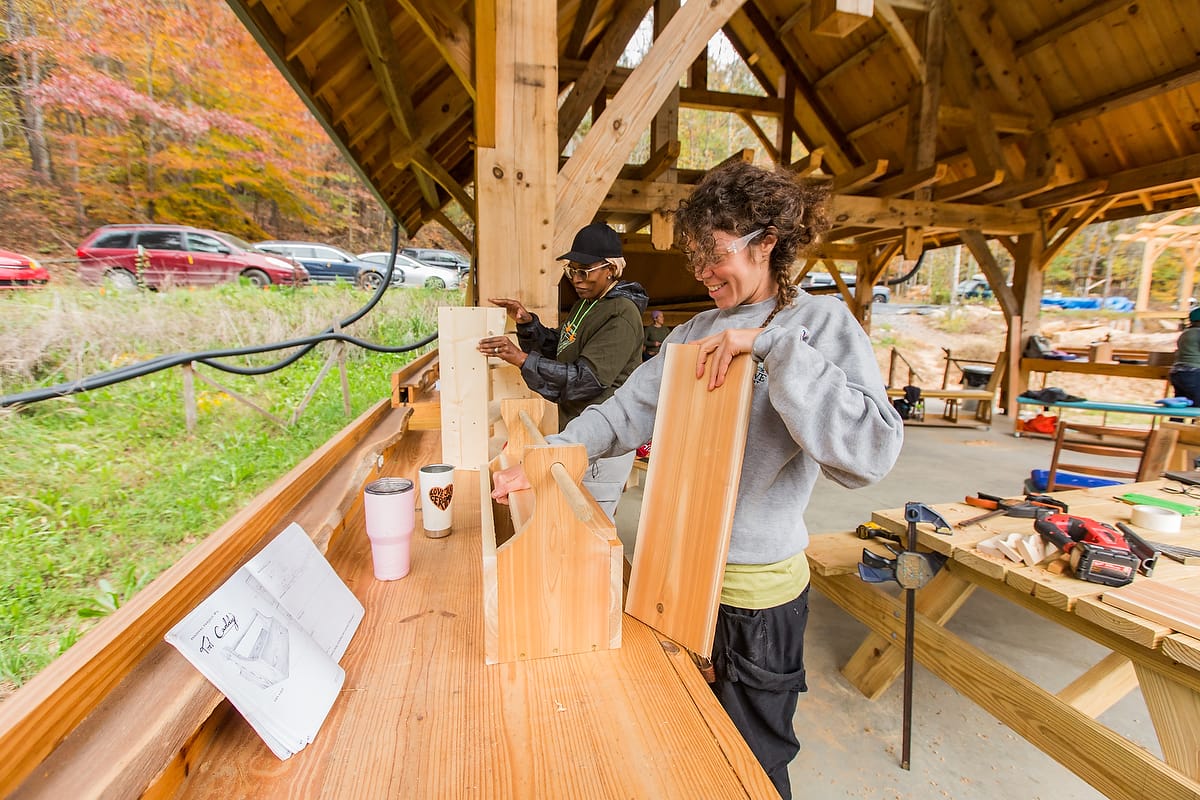
Build your ideas into being in our adult woodworking classes for beginners
You might be asking yourself, can I really learn carpentry in a weekend woodworking class for beginners? And we’re here to tell you that, yes, it’s absolutely possible! In one long weekend, you can understand how to work with wood, get comfortable with tools, and learn how to plan out and design your own simple carpentry projects. We’ve seen it happen time and again, with hundreds of satisfied students.
Of course, people spend lifetimes perfecting their woodworking skills, especially those who build houses or do fine finish work like cabinetry or furniture making. It’s not realistic to learn to do these high-level kinds of projects in a long weekend workshop. However, you can take the first steps that every carpenter and fine woodworker once took. And you’ll leave with the ability to turn your basic ideas into reality, right away.
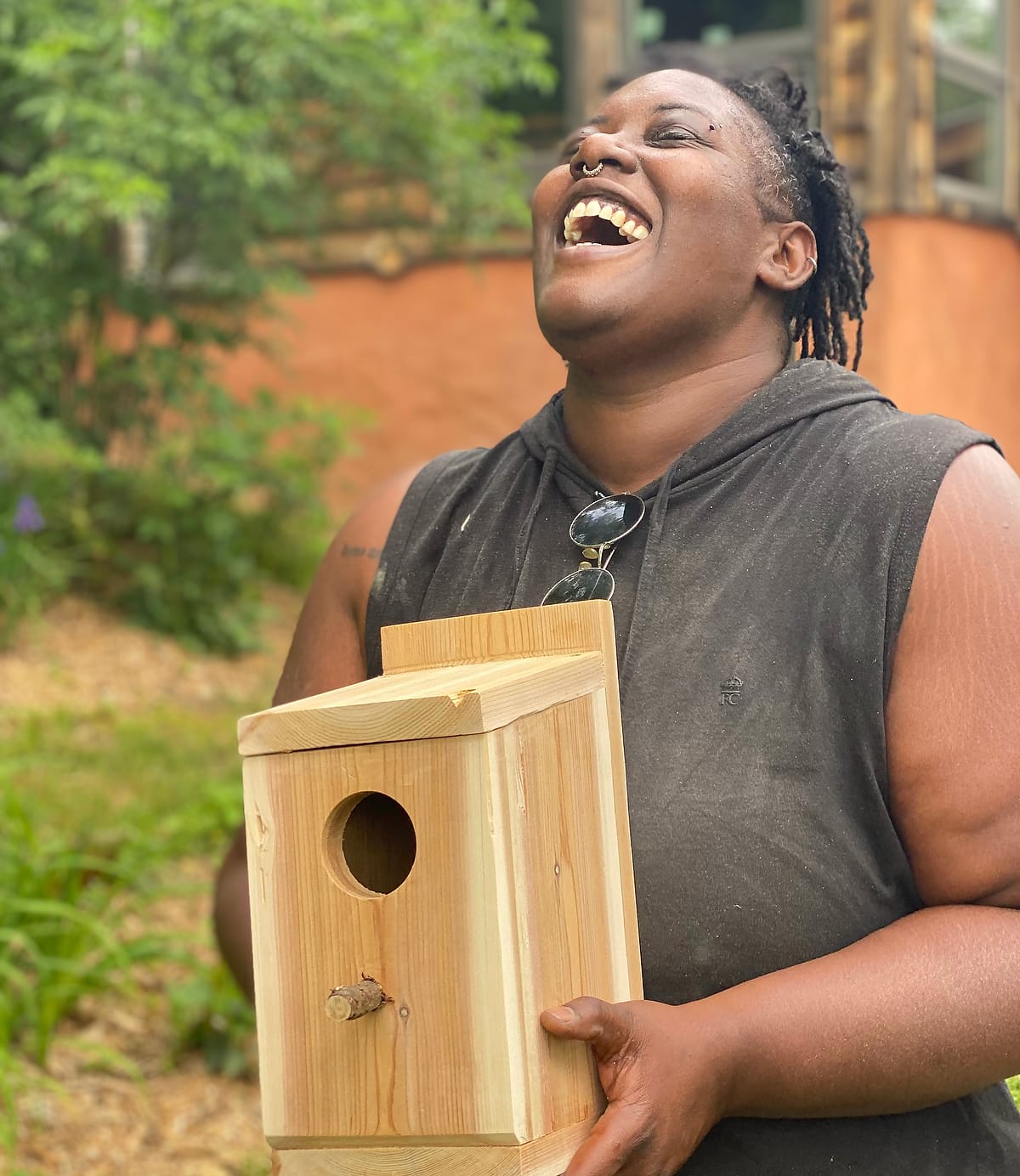
Frequently Asked Questions about the Beginner Woodworking Classes for Adults
In this woodworking class for beginners, you’ll learn how to properly and safely use the following tools:
- Carpenter’s pencil
- Measuring tape
- Speed square
- Chalk line
- Utility knife
- Table saw
- Chop saw/miter saw
- Circular saw
- Impact driver
- Drill
- Hammer
- Cat’s paw
- Level
- Hand saw
Yes, you will need to bring some tools, but not all of them! All the tools and materials we ask you to get a hold of for this class will continue to be useful afterwards as you practice and hone your carpentry and woodworking skills. This does not mean that you have to spend hundreds of dollars on the required tools. You could spend only $30-40 if you just get the bare bones. Or, you could choose to borrow tools from friends or family members. If you get all the required and optional tools, and choose the very best brands, then you could be talking big bucks — and an awesome toolkit. Check out our list of both required and optional tools/supplies here.
You’ll learn how to use most of the tools that are used in structural building, and some of the basic techniques, but this is not a structural building class. If you’re excited to build buildings, check out our Advanced Women’s Carpentry Class (in combination with the basics class) or our Tiny House Workshop.
This is a woodworking class for beginners, but it also covers more advanced power tools, as well as the proper ways to measure and design. If you have some basic skills, but don’t feel totally confident in your technique or comfortable using bigger power tools, you’ll still get a lot out of this class. If you feel totally confident building small to medium projects on your own, this class may be too basic for you. Consider taking our Women’s Advanced Carpentry or Tiny House Workshop if you want to really strengthen your structural building skills.
We used to let folks who thought they had enough experience take our Advanced Carpentry Class without taking the beginner’s class first. Time after time, we found that these students did not have the foundational safety and ergonomic tool-use skills that graduates of the beginner class did. This boosted our confidence in the power of the basics class!
It’s clear that in four days so much more can be taught in this concentrated class than one might learn in years on their own. Because of this, we are now strict about only letting graduates of the beginner’s class into the advanced class.
This class is accessible to students with at least a moderate level of physical strength and energy. Part of the purpose of a woodworking class for beginners is that people of different physical abilities are welcomed and accommodated. Throughout the days, there are opportunities to drink water, eat snacks, and take breaks. We’ve had students from a wide range of ages and physical abilities thrive in the class. It is worth considering that our campuses are hilly and rustic, there is a lot of walking on uneven ground, and the woodshop is not accessible to folks with certain disabilities. Read more about our campuses here.
You will have three project options to choose from: a birdhouse, a simple shelf, or a tool caddy. During the design and building phases, you’ll have the opportunity to customize the dimensions and add artful details. In the process of personalizing your design, you will learn the skills for reverse engineering an object that already exists, creating a cut list and plan to recreate it, and the process for picturing a project in your head and creating a cut list based on that.
If you prefer to work with a done-for-you design, that’s an option, too. In that case, you could choose a project design that is identical to the example projects presented during class. Doing this means all the math will be done for you.
Most community colleges offer a basic woodshop class, and some of them are awesome. What makes this class unique is that it is intensive; you will likely leave this four-day experience different than when you came. We have taught well over 50 basic carpentry classes, and our staff and teachers are obsessed with continuous improvement. We take feedback and make changes, resulting in the best possible class that we can offer. These are reasons, along with the community experience and the beautiful outdoor classroom, why traveling to Wild Abundance may be the right choice for you.
You’ll gain the skills to design and build custom furniture in this class, but it won’t be fancy. This is not a fine woodworking class that covers super-tight joinery or wood finishing. However, we do address project design, including how to look at an object and reverse engineer it into its pieces, so that you can copy things that you like the look of. We also show you how to make variations and customize projects. Additionally, you’ll learn how to take a concept in your head, design it, and then build it.
The nature of this class is very inclusive and supportive, regardless of age or other differences that students might have. We’ve had a wide range of students take this class. The average age of students has been around 45. That being said, our oldest student was 74 and our youngest student was a teenager. We usually get about 35% of students who are over 50, 40% between 35-50, and 25% under 35.
In short, no. Most of our carpentry students are women, and while we once offered an all-genders advanced woodworking class, it didn’t fill. If you’d like to take your carpentry skills to the next level and already have an introductory class under your belt, we recommend joining our Tiny House Class or our 4-Month Carpentry Training Program.
Instructors
Madison Moore
Alex Kilgore
Alexandra Miller
Mana Vermeulen-McLeod
Erica Doud
Our Woodworking Classes for Adults are held near Asheville, NC at the Wild Abundance Paint Fork Campus
Our Paint Fork campus is a bustling creekside landscape with gorgeous mountain views, a breathtaking timber-framed pavilion classroom, and spacious covered open-air wood shops for learning building and carpentry in all weather, plus other lovely features. The Paint Fork campus is 30 minutes north of Asheville.
Please note: our campuses are all unconventional, with rustic amenities and uneven ground. Read more about planning your trip and about our campuses. You’ll receive detailed directions on how to get here upon registration.
You’ve got several options of where to stay during your class. Some students camp, some locals commute, and others choose to rent accommodations with more creature comforts.
Onsite camping (with your own warm bedding and rainproof tent or hammock) is available for free to all students (including locals) during class. Some set-up-for-you tents are available with cots and cozy bedding for a flat fee.
Campers and all students have access to a lovely outdoor kitchen equipped with a stove and hot and cold water, plus pots and pans, knives and cutting boards, bowls, plates, and utensils, along with an outdoor shower with hot and cold running water and an outhouse. If you’d rather rent a hotel, house or cottage, there are many available. We’ll share a curated list of nearby options once you’ve registered.
So you can better plan your trip to come learn with us, here’s some info on accommodations we offer, or that we link to in the student handbook you’ll receive upon registration. Below it you’ll find info on transportation.
- Camping with your own gear: free
- Staying in a large tent with a cozy cot and bedding that we set up for you: $200 flat fee; you can stay there anytime from 5pm before the first day of your class, to 12pm the day after your class ends.
- Hyper-local off-campus single rentals: $40-$2000/night + fees
- Hyper-local off-campus couples rentals: $20-100/person/night + fees
- Hyper-local off-campus group rentals: $25-$86/person/night + fees
Wild Abundance students are given awesome discounts at a local hotel, and a hyper-local inn. More information given in the student handbook upon registration.
Getting a place or renting a car with a group of fellow students and carpooling are great ways to make connections and reduce costs! We share contact info for each class so you can get in touch and make plans together. Everyone has a chance to keep their info private if they choose.
You won’t need a car during your class. There’s a chance you may want to run an errand or go out to dinner with fellow students, and if this happens, it’s highly likely that another student with a car will be happy to give you a lift.
We’ve also got a list of folks who will do airport and grocery shuttle runs for $50-$80 each way. We share this information in the student handbook when you register. If you’d rather rent a car, those run anywhere from $45-$200/day. Just like with lodging, teaming up with a group of fellow students to share a car rental can help build connections and reduce costs.
Pricing for our Adult Beginner Woodworking Class
Regular Pricing: $850 – $1,700
*Please pay what you can within this range. The median price helps cover the class costs. Choose the low end if you’re low income, or the maximum fee if your household earns over $115,000/year. Place yourself within this range based on your income.
